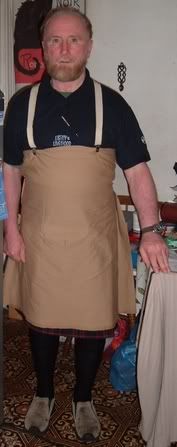|
-
13th July 06, 03:06 PM
#1
Jerry Lee at What Price Glory does reproduction WWI British Army kilt aprons (based on a 1917 style) - he also offers Canadian ones.
I bought two (British Army style) off him to use as aprons in my workshop. As one would expect, the tops come up to the ribcage, and so there are three draw-strings, and there's a pocket in the front where the sporran would be (or where one would expect a pocket on an apron).
The apron is a complete wrap around affair, with a single side opening on the right. It is pleated at the back of the skirt, and flat at the front.
-
-
13th July 06, 03:56 PM
#2
See 'Come On Highlanders'-by Alec Weir-published by Sutton.
The apron was for camouflage-it would not protect the kilt in a trench.
James
-
-
14th July 06, 02:38 PM
#3
Here're some pictures of the British Army 1917 pattern Aprons Kilt Khaki Highlanders (reproduction)(that I bought from Maj Jerry Lee of What Price Glory) to illustrate the points that James is making.

It clearly goes all the way round, lacing up on the right side. The top of the apron is high up on the chest, and the bottom edge is roughly on a level with the selvage edge of the kilt. The front pocket (about where the sporran would be) isn't that clear on the photograph.

I would imagine that the soldiers would have sewn buttons onto the apron and "acquired" another set of braces (they would be wearing the issued set on the kilt proper). The khaki short coat would be worn over the top, and the webbing personal load carrying equipment would be on top of that.
My grandfather used to say that in the march up to Passchendaele they would be carrying nearly their own body-weight. When I was in the service we calculated that the WWI infantryman on the line of march would be carrying about 109 lbs: no wonder that if you fell off the duck boarding at Passchendaele, you drowned.
-
-
15th July 06, 03:11 AM
#4
Touching on a soldiers load-well an infantry man of either WW1 or today-a lot of kit is needed just to survive, and often the immediate action is only a prelude to holding the ground hopefully won.
So thinking back to the fifties-yes I am that ancient!
Aside from the basic battle order-of pack, water bottle, ammunition pouches, and personal weapon-oh yes bayonet too.
There would be a pick or shovel, probably an extra bandolier of ammunition--possibly a couple, two HE grenades, maybe an incendiary bomb-: then just as you thought life was interesting enough-a couple of mortar bombs would be added. besides shared amongst the lads would be such fun things as 2"mortars and their bombs-boxes of bren magazines--too such things as radios and batteries, very pistols and cartridges--the list goes on and on.
An enormous weight, which has been picked upon by some as being unfair on the soldiers and not giving them a chance to get across no man's land. However without that weight-they would not have stood a chance when the counter attack came in-and that was German policy-an immediate counter attack.
Now after ninety years we have personnel carriers-helicopters and all sorts of ways of riding into action-so by now it stands to reason that the soldiers load must be a lot lighter--does any modern soldier believe that?
James
-
-
15th July 06, 06:12 AM
#5
Additionally, as has been pointed out on this forum before, soldiers used to also be much smaller built than modern US and Brit ones. They used to be fairly small and lean. Now most are muscle men, 5'6" to 6'+. This is also primarily a recent (latter 20th Century) thing.
Imagine all the soldiers (as they used to be built) carrying all that stuff. Yet, that is what they were used too, especially compared to today (with modern motorized -and rotored- rapid resupply.
-
-
15th July 06, 01:45 PM
#6
 Originally Posted by James
Touching on a soldiers load-well an infantry man of either WW1 or today-a lot of kit is needed just to survive, and often the immediate action is only a prelude to holding the ground hopefully won.
. . .
Now after ninety years we have personnel carriers-helicopters and all sorts of ways of riding into action-so by now it stands to reason that the soldiers load must be a lot lighter--does any modern soldier believe that?
James
James,
It hasn't worked out that way . . . one of my sons was in the US Marines, in Iraq last year. He said that he routinely carried a pack that weighed in excess of 100 lbs. when out on patrol.
Mark
-
-
15th July 06, 10:01 PM
#7
That's why I closed by asking if any modern soldier believed that!
James
-
-
16th July 06, 05:33 PM
#8
The 'Tommy Atkins' of the Roman Legions was 'Marcus the mule - two thousand years and not much has changed - not even the gripeing.
-
 Posting Permissions
Posting Permissions
- You may not post new threads
- You may not post replies
- You may not post attachments
- You may not edit your posts
-
Forum Rules
|
|



















Bookmarks